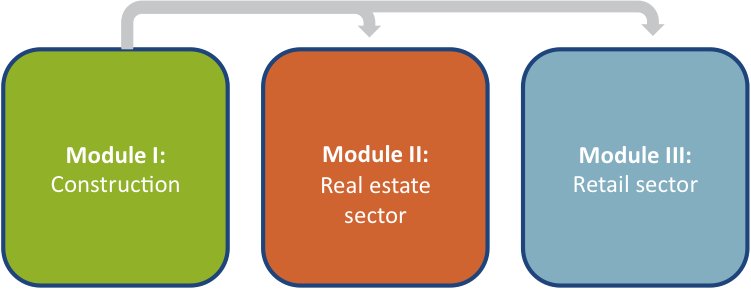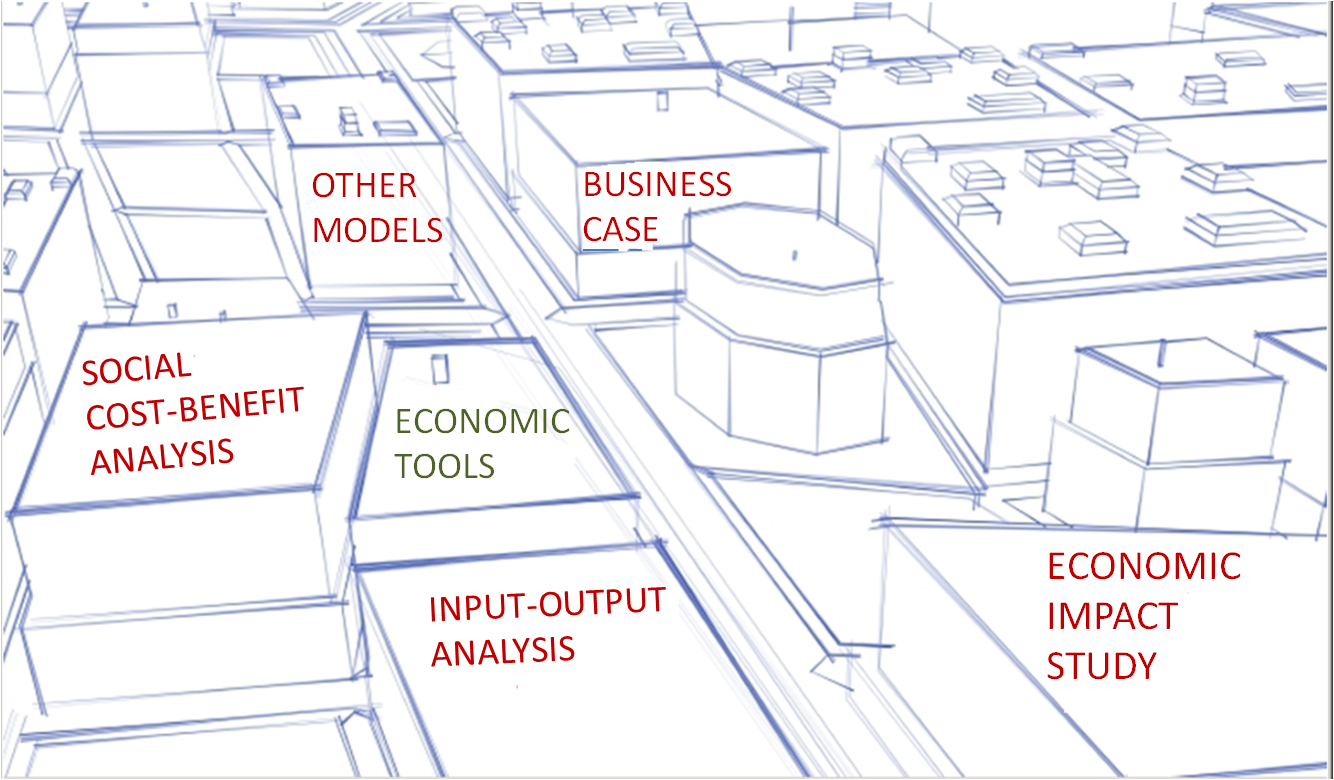Difference between revisions of "Economic Impact Study"
| (6 intermediate revisions by one other user not shown) | |||
| Line 26: | Line 26: | ||
[[File:EIS_steps_V02.png|750px| Source: Decisio (2012)]] |
[[File:EIS_steps_V02.png|750px| Source: Decisio (2012)]] |
||
Source: Decisio (2012) |
Source: '''[http://www.decisio.nl/?lang=en Decisio (2012)]''' |
||
====Step 1: measuring the direct impact==== |
====Step 1: measuring the direct impact==== |
||
| Line 33: | Line 33: | ||
An example: [[File:Itäkeskus shopping centre.JPG|thumb|Itäkeskus shopping centre]] |
An example: [[File:Itäkeskus shopping centre.JPG|thumb|Itäkeskus shopping centre]] |
||
{{quote|The building of a new shopping mall will create temporarily jobs in the construction sector and permanent jobs in retail and affiliate sectors such as cleaning and maintenance. In addition, the real estate owners will generate income from lease contracts and the local government will be able to collect tax revenues.}} |
{{quote|The building of a new shopping mall will create temporarily jobs in the construction sector and permanent jobs in retail and affiliate sectors such as cleaning and maintenance. In addition, the real estate owners will generate income from lease contracts and the local government will be able to collect tax revenues.}} |
||
Based on the scope of the economic impact study, economists will focus their effort on those sectors in the pre-defined impact area that are affected most by the studies entity. For the example above, for instance, economists would focus their attention on the construction sector, the real estate sector and the retail sector. To do this, some economists create different modules in order to determine the interrelations between the different sectors (see example below): |
Based on the scope of the economic impact study, economists will focus their effort on those sectors in the pre-defined impact area that are affected most by the studies entity. For the example above, for instance, economists would focus their attention on the construction sector, the real estate sector and the retail sector. To do this, some economists create different modules in order to determine the interrelations between the different sectors (see example below): |
||
| Line 39: | Line 39: | ||
[[File:EIS_modules_V01.png|400px| Source: Decisio (2012)]] |
[[File:EIS_modules_V01.png|400px| Source: Decisio (2012)]] |
||
Source: Decisio (2012) |
Source: '''[http://www.decisio.nl/?lang=en Decisio (2012)]''' |
||
====Step 2: measuring the indirect and induced impact==== |
====Step 2: measuring the indirect and induced impact==== |
||
The next step for economists is to estimate the indirect economic effects on the economy. These secondary impacts are more difficult to quantify and there are different approaches possible to do this. In case enough economic data/statistics are available, economists could use an [[Input-output analysis|input-output model]] to estimate the indirect effects. |
The next step for economists is to estimate the [[Secondary economic impact|indirect economic effects]] on the economy. These secondary impacts are more difficult to quantify and there are different approaches possible to do this. In case enough economic data/statistics are available, economists could use an [[Input-output analysis|input-output model]] to estimate the indirect effects. |
||
| ⚫ | {{quote|An '''[[Input-output analysis|input-output model]]''' is a quantitative economic tool that captures the inter-sectoral transactions. It contains large tables of data that describe the transactions in pre-defined impact areas. These tables help the users to track the flow of money from one sector to the next. The technique of input-output analysis is originally created by Wassily Leontief (1965).}} |
||
{| class="wikitable" |
|||
|- |
|||
| ⚫ | | |
||
|} |
|||
Input-output models result in so called 'Leontief multipliers'. These [[Multiplier effect|multipliers]] capture the size of these indirect effects from a change. For example, an economic multiplier of 2.3 would mean that for each euro spent, EUR 1.50 is additional indirect spending (indirect and induced). There are several types of multipliers depending on the measured [[economic output]] (income, value added, employment etc.). |
|||
====Step 3: Estimating the total economic impact==== |
====Step 3: Estimating the total economic impact==== |
||
| Line 80: | Line 75: | ||
== Related subjects == |
== Related subjects == |
||
Urban planning processes employ a host of other economic tools/models: |
Urban planning processes employ a host of other economic tools/models: |
||
* [[ |
* [[Input-output analysis|Input-output analysis]] |
||
* [[ |
* [[Social cost-benefit analysis|Social cost-benefit analysis]] |
||
* [[ |
* [[Business case|Business case]] |
||
* [[ |
* [[Other economic tools|Other economic tools]] |
||
* [[ |
* [[Economic tools|Economic tools]] |
||
See also the clickable map below: |
See also the clickable map below: |
||
Latest revision as of 23:02, 19 January 2018
An economic impact study (assessment or analysis) is an economic tool/method traces the total economic activity generated by a policy, investment, project, venue or activity in a pre-defined impact area. This impact area is determined by the nature of the explored case study and can enhance an individual city, region or an entire country. Economic impact studies support the decision making process to understand the economic consequences of all kinds of relevant questions such as:
- How much income does a spatial development project generate for city X?
- What portion of sales by local business is due to sector Y?
- How many jobs in region Z are supported by the construction sector?
- How much tax revenues will project 1 generate?
- How much income do households and businesses generate in area 2?
- What will the permanent and temporary economic effects be of project 3?
The wide scope of the above mentioned questions already suggests that economic impact studies are one of the most often applied economic tools to facilitate the preparation of a robust urban plan. One should keep in mind, however, that economic impact studies do not include the environmental and broader social impacts such as quality of life. Hence, impact studies are only one of the tools available for decision makers.
Contents
Relevance
Knowledge about economic models/tools such as an economic impact study can help the urban planner to systematically survey all the relevant (socio-economic) impact caused by an urban development and security threats. This insight will help the responsible urban planners to make the best choices from an socio-economic point of view.
Measured economic effects
The economic impact model calculates the direct (primary), indirect and induced (secondary) effects of the urban development plan:
- Direct effects are generally defined as production changes associated with the immediate effects of change in expenditures. An impulse in construction activity, for example, leads to an increase in wages, profits, taxes paid etc.
- Indirect effects are generally defined as production changes resulting from various rounds of re-spending of the receivers of the direct spending impulse in other backward-linked sectors. Architects and brick suppliers, for example, will receive orders from the construction companies responsible for the construction of the ordered development.
- Induced effects are the effects resulting from the re-expenditures of households. Employees of companies earn wages that are spend on goods and services. This means that not only the purchases of the construction companies are included, but also the expenses of the employees of the construction companies etc.
The model behind the economic impact study
There are multiple ways to perform an economic impact study, but in general, economists use models that exist of the following steps:
Source: Decisio (2012)
Step 1: measuring the direct impact
The direct impact of a spatial development contains the created direct expenditures and are associated with the first round of spending in the economy (without any subsequent transactions).
An example:
The building of a new shopping mall will create temporarily jobs in the construction sector and permanent jobs in retail and affiliate sectors such as cleaning and maintenance. In addition, the real estate owners will generate income from lease contracts and the local government will be able to collect tax revenues.
Based on the scope of the economic impact study, economists will focus their effort on those sectors in the pre-defined impact area that are affected most by the studies entity. For the example above, for instance, economists would focus their attention on the construction sector, the real estate sector and the retail sector. To do this, some economists create different modules in order to determine the interrelations between the different sectors (see example below):
Source: Decisio (2012)
Step 2: measuring the indirect and induced impact
The next step for economists is to estimate the indirect economic effects on the economy. These secondary impacts are more difficult to quantify and there are different approaches possible to do this. In case enough economic data/statistics are available, economists could use an input-output model to estimate the indirect effects.
An input-output model is a quantitative economic tool that captures the inter-sectoral transactions. It contains large tables of data that describe the transactions in pre-defined impact areas. These tables help the users to track the flow of money from one sector to the next. The technique of input-output analysis is originally created by Wassily Leontief (1965).
Step 3: Estimating the total economic impact
In the final step, not only the direct and indirect impacts are added up, but also the socio-economic effects that are not quantifiable are assessed. Pubic education or research and development, for example, create benefits to society that are very difficult to quantify and to link to a specific institute.
Case study examples
- The public authorities of City X wish to gain insight in the extensive economic impact of a spatial development plan in order to support the the decision making process to determine the optimal zoning plan.
- An application has been submitted by a large chain retail store to amend the official zoning plan to allow a new 2,000 square meter retail store on the outskirts of town. The public authorities aim to check if the suggested positive impact on the local economy is true before a decision is made.
- The regional authorities of an economic core region wish to find out what the economic impact would be of a terrorist assault on its main business and financial district.
- Local authorities wish to gain insights in the impact of crime on the local economy.
Data collection and analyses
The data and information used by model engineers are mostly available from existing data or previous studies. The following list sums up some of the information needed:
| Supply information | Demand information |
|---|---|
| Demographic statistics (resident population, employment statistics, number and type of businesses etc.) | Statistical data on consumption, investments, export (e.g., the regional and local volume of tourist spending) |
| The details of the Supporting report (amount of planned hotel rooms, residential houses etc.) | Demand surveys (e.g., for the real estate market, construction, and tourism) |
| Qualitative economic information (expected economic growth, the quality of the local economy etc.) |
Limits of economic models
Like any other economic tool, economic impact studies have their fundamental and methodological limits.
Related subjects
Urban planning processes employ a host of other economic tools/models:
- Input-output analysis
- Social cost-benefit analysis
- Business case
- Other economic tools
- Economic tools
See also the clickable map below:
Other related subjects:
Footnotes and references



